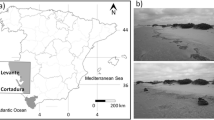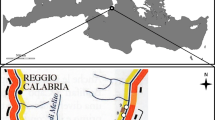Abstract
Beach nourishment and groynes building were implemented to counteract erosion in sandy beaches located at San Rossore natural park (Tuscany, Italy), near the mouth of Arno river. From 2000 to 2003, nine groynes were built along 3.6 km of coastline at intervals of ca. 400 m, and two of the eight beach segments were filled with marble gravel. Here, we analysed the effects of these beach changes on the abundance and behaviour of the amphipod Talitrus saltator, using field and laboratory observations. Sampling with pitfall traps in order to use the capture frequency as a proxy of abundance was performed bimonthly from September 2004 to January 2006, and orientation experiments were carried out in autumn (2004 and 2005), and spring and summer 2005. Physical variables (beach width, swash width, beach slope, sand penetrability, mean grain size and salinity) were also recorded. The abundance of T. saltator increased with the distance from the river mouth, towards sites with: negligible amounts of marble locally used for nourishment; higher beach width and salinity; lower slope and penetrability values; medium grain sizes, and during the spring/summer seasons. A Generalized Linear Model with a predictive power of 64.5% considered three main descriptors in the model as significant: distance from the river mouth, sand penetrability and a seasonal factor. Orientation experiments showed a highly variable behaviour among sites, depending on coastal stability: at the site stabilized by the concurrent actions of nourishment and groynes protection measures, sandhoppers were oriented to the shoreline direction by using a sun compass; alternatively, at a site situated only 2 km from the nourished sites, they showed scattered orientation. These between-site differences in orientation, described through Spherically Projected Linear Models, were consistent throughout the study period. Different responses obtained at the individual (orientation) and population (captures) levels stress the need to account for several bioindicators to characterize biotic responses to both natural and anthropogenic changes in sandy beaches.






Similar content being viewed by others
References
Agresti A (2002) Categorical data analysis. Wiley Series in Probability and Statistics, New York, 710 pp
Borgioli C, Martelli L, Porri F, D’Elia A, Marchetti GM, Scapini F (1999) Orientation in Talitrus saltator (Montagu): trends in intrapopulation variability related to environmental and intrinsic factors. J Exp Mar Biol Ecol 238:29–47
Cipriani LE, Ferri S, Iannotta P, Paolieri F, Pranzini E (2001) Morfologia e dinamica dei sedimenti del litorale della Toscana settentrionale. Stud Cost 4:119–156
Colombini I, Fallaci M, Milanesi F, Scapini F, Chelazzi L (2003) Comparative diversity analysis in sandy littoral ecosystems of the western Mediterranean. Estuar Coast Shelf Sci 58S:93–104
Colombini I, Chaouti A, Fallaci M, Gagnarli E, Scapini F, Bayed A, Chelazzi L (2007) Effects of freshwater river discharge on terrestrial arthropods in Atlantic and Mediterranean sandy shores. In: Proceedings of the MEDCORE international conference, Firenze University Press, Florence, pp 237–265
Defeo O, McLachlan A (2005) Patterns, processes and regulatory mechanisms in sandy beach macrofauna: a multi-scale analysis. Mar Ecol Prog Ser 295:1–20
Defeo O, Gómez J (2005) Morphodynamics and habitat safety in sandy beaches: life history adaptations in a supralittoral amphipod. Mar Ecol Prog Ser 293:143–153
Fallaci M, Colombini I, Lagar M, Scapini F, Chelazzi L (2003) Distribution patterns of different age classes and sexes in a Thyrrenian population of Talitrus saltator (Montagu). Mar Biol 142:101–110
Fanini L, Martín Cantarino C, Scapini F (2005) Relationshpis between two Talitrus saltator populations and the impacts of activities linked to tourism. Oceanologia 47:93–112
Fanini L, Scapini F, Khattabi A (2007) Sandhopper orientation integrates environmental information. Preliminary considerations on the case-study of Laou River mouth, Morocco. In: Proceedings of the MEDCORE international conference, Firenze University Press, Florence, pp 189–201
Fisher NI (1993) Statistical analysis of circular data. Cambridge University Press, Cambridge, p 277
Folk RL, Ward WC (1957) Brazos river bar: a study in the significance of grain size parameters. J Sediment Petrol 27:3–26
Guisan A, Edwards TC Jr, Hastie T (2002) Generalized linear and generalized additive models in studies of species distributions: setting the scene. Ecol Modell 157:89–100
Hartwick RF (1976) Aspects of celestial orientation behavior in talitrid amphipods. In: De Coursey PJ (ed) Biological rhythms in the marine environment,Columbia, S. C, pp 189–197
Kennedy F, Naylor E, Jaramillo E (2000) Ontogenetic differences in the circadian locomotor activity rhythm of talitrid amphipod crustacean Orchestoidea tubercolata. Mar Biol 137:511–517
Lercari D, Defeo O (2003) Variation of a sandy beach macrobenthic community along a human-induced environmental gradient. Estuar Coast Shelf Sci 58S:17–24
Lercari D, Defeo O (2006) Large-scale diversity and abundance trends in sandy beach macrofauna along full gradients of salinity and morphodynamics. Estuar Coast Shelf Sci 68:27–35
Lozoya JP, Defeo O (2006) Effects of a freshwater canal discharge on an ovoviviparous isopod in an exposed sandy beach. Mar Fresh Res 57:421–428
Marchetti GM, Scapini F (2003) Use of multiple regression models in the study of sandhopper orientation under natural conditions. Estuar Coast Shelf Sci 58S:207–215
Marques JC, Anastácio P (2002) Integration and interpretation of ecological data at population level. In: Scapini F (ed) Baseline research for the integrated sustainable management of Mediterranean sensitive coastal ecosystems. A manual for coastal managers, scientists and all those studying coastal processes and management in the Mediterranean. IAO, Florence, pp 155–164
Marques JC, Gonçalves SC, Pardal MÂ, Chelazzi L, Colombini I, Fallaci M, Bouslama MF, ElGtari M, Charfi-Cheikrouha F, Scapini F (2003) Comparison of Talitrus saltator (Amphipoda, Talitridae) biology, dynamics and secondary production in Atlantic (Portugal) and Mediterranean (Italy and Tunisia) populations. Estuar Coast Shelf Sci 58:127–148
McLachlan A, Jaramillo E (1995) Zonation on sandy beaches. Oceanogr Mar Biol Ann Rev 33:305–335
Nardi M, Morgan E, Scapini F (2003) Seasonal variation in the free-running period in two Talitrus saltator populations from Italian beaches differing in morphodynamics and human disturbance. Estuar Coast Shelf Sci 58S:199–206
Osenberg CW, Schmitt RJ (1996) Detecting ecological impacts. Concepts and applications in coastal habitats. Academic, New York, p 401
Peterson CH, Bishop M (2005) Assessing the environmental impacts of beach nourishment. Bioscience 55:887–896
Peterson CH, Bishop M, Johnson GA, D’Anna LM, Manning LM (2006) Exploiting beach filling as an unaffordable experiment: benthic intertidal impacts propagating upwards to shorebirds. J Exp Mar Biol Ecol 338:205–221
R packages “effects”, John Fox (2006) Effects Display for Linear and Generalized Linear Models. R Package Version 1.0-9
Salas F, Marcos C, Neto JM, Patrício J, Pérez-Ruzafa A, Marques JC (2006) User-friendly guide for using benthic ecological indicators in coastal and marine quality assessment, Ocean Coast Manage 49:308–331
Scapini F, Chelazzi L, Colombini I, Fallaci M (1992) Surface activity, zonation and migrations of Talitrus saltator on a Mediterranean beach. Mar Biol 112:573–581
Scapini F, Buiatti M, De Matthaeis E, Mattoccia M (1995) Orientation behaviour and heterozygosity of sandhopper populations in relation to stability of beach environments. J Evol Biol 8:43–52
Scapini F (1997) Variation in scototaxis and orientation adaptation of Talitrus saltator populations subjected to different ecological constraints. Estuar Coast Shelf Sci 44:139–146
Scapini F, Campacci F, Audoglio M (1999) Variation among natural populations of Talitrus saltator (Amphipoda): morphometric analysis. Crustaceana 72:659–672
Scapini F, Fasinella D (1990) Genetic determination and plasticity in the sun orientation of natural populations of Talitrus saltator. Mar Biol 107:141–145
Scapini F, El Gtari M, Marchetti GM (2002) Behavioural changes as indicators of beach stability. In: Scapini F (ed) Baseline research for the integrated sustainable management of Mediterranean sensitive coastal ecosystems. A manual for coastal managers, scientists and all those studying coastal processes and management in the Mediterranean. IAO, Florence, pp 140–153
Scapini F, Chelazzi L, Colombini I, Fallaci M, Fanini L (2005) Orientation of sandhoppers at different points along a dynamic shoreline in southern Tuscany. Mar Biol 147:919–926
Scapini F (2006) Keynote papers on sandhopper orientation and navigation. Mar Fresh Behav Physiol 39:73–85
Ugolini A, Scapini F, Beugnon G, Pardi L (1988) Learning in Zonal orientation of Sandhoppers. In: Behavioral Adaptation to Intertidal Life, edited by Guido Chelazzi and Marco Vannini. Plenum Publishing Corporation, New York, NY, pp 105–118
Wesławski JM, Stanek A, Sievert A, Beer N (2000) The sandhopper (Talitrus saltator, Montagu 1808) on the Polish Baltic coast. Is it a victim of the increased tourism? Oceanol Stud 24:77–87
Acknowledgements
The study was supported by the Accordo per Scambi Culturali e Cooperazione Interuniversitaria Università di Firenze-Universidad de la República de Uruguay; we also received partial financial support from MEDCORE and WADI projects. We thank the Regional Park of Migliarino-San Rossore-Massaciuccoli for supplying information and logistic support, in particular A. Perfetti, A. Giuntini and M. De Prosperis. We thank L. Chelazzi, E. Gagnarli, L. Cipriani, E. Morgan, S. Tommasini, E. Balbo, E. Pranzini and K. Nordstrom for their valuable suggestions and helpful comments. Experiments were carried out in compliance with Italian law.
Author information
Authors and Affiliations
Corresponding author
Additional information
Communicated by R. Cattaneo-Vietti.
Rights and permissions
About this article
Cite this article
Fanini, L., Marchetti, G.M., Scapini, F. et al. Abundance and orientation responses of the sandhopper Talitrus saltator to beach nourishment and groynes building at San Rossore natural park, Tuscany, Italy. Mar Biol 152, 1169–1179 (2007). https://doi.org/10.1007/s00227-007-0764-3
Received:
Accepted:
Published:
Issue Date:
DOI: https://doi.org/10.1007/s00227-007-0764-3




